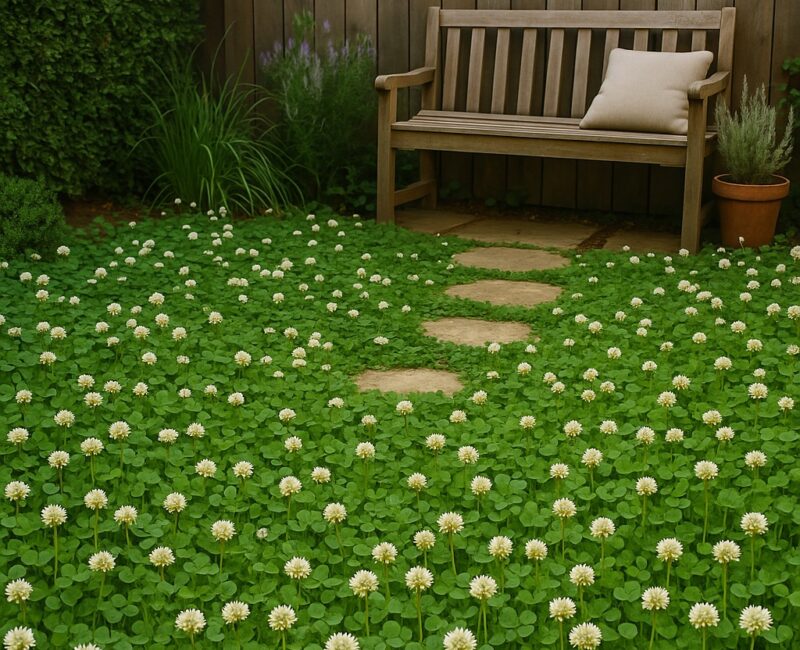The Lawn Revolution of 2025
Traditional lawns are changing. For decades, short-cut grass symbolized the “ideal yard.” But in 2025, that picture is being reimagined with clover lawns—eco-friendly, lush green spaces that save water, support pollinators, and require far less maintenance than standard grass.
Gardeners in the US and Europe are saying goodbye to thirsty grass lawns and embracing clover for its sustainability, beauty, and resilience. It’s not just a trend—it’s a lifestyle change for homeowners who want healthier gardens and a lighter environmental footprint.
Read more – The Secret Gardening Mistakes Killing Your Plants Silently
This guide explores why clover lawns are booming in popularity, how to plant and maintain them, and why they may be the perfect choice for your yard.
What Is a Clover Lawn?
A clover lawn is a yard or green space planted primarily with clover (Trifolium species) instead of or alongside traditional turfgrass.
Unlike grass, which demands constant mowing, watering, and fertilizing, clover is:
- Naturally low-maintenance.
- Drought-tolerant.
- Resistant to pests.
- Attractive to pollinators like bees and butterflies.
Clover lawns can be full coverage (pure clover) or mixed lawns (clover + grass). Both options create a soft, green carpet that feels great underfoot and stays vibrant even in hot summers.
Why Clover Lawns Are Trending in 2025
The clover lawn trend is spreading quickly for several reasons:
1. Water Conservation
Clover requires less water than grass, making it ideal for drought-prone areas.
2. Eco-Friendly Appeal
No need for chemical fertilizers—clover fixes nitrogen naturally, enriching soil health.
3. Low Maintenance
Clover grows to a manageable height, meaning less mowing. Some homeowners cut only a few times a year.
4. Pollinator Friendly
Clover flowers provide nectar for bees and butterflies, boosting local biodiversity.
5. Aesthetic Charm
White, pink, or purple clover blooms add beauty to a lawn, creating a soft meadow-like effect.
Types of Clover for Lawns
Not all clover is the same. Here are the top choices for lawns in the US and Europe:
1. White Clover (Trifolium repens)
- The most popular choice.
- Low-growing and spreads easily.
- Produces small white blooms.
2. Microclover
- A smaller variety of white clover.
- Blends well with grass.
- Less flowering—great for tidy lawns.
3. Red Clover (Trifolium pratense)
- Taller than white clover.
- Produces pinkish-red blooms.
- Works well in larger yards or naturalized areas.
4. Alsike Clover (Trifolium hybridum)
- Tolerates wet soil better than other types.
- Produces pale pink blooms.
- Commonly used in Europe.
How to Plant a Clover Lawn
Step 1: Choose Your Clover Type
Pick based on your climate, soil, and whether you prefer full clover or a clover-grass mix.
Step 2: Prepare the Soil
- Remove weeds and debris.
- Loosen soil with a rake.
- Add compost for better germination.
Step 3: Sow the Seeds
- Scatter seeds evenly across the area.
- Rake lightly so seeds contact the soil.
- Water gently but consistently for 7–10 days.
Step 4: Care During Establishment
- Keep soil moist until clover sprouts.
- Avoid mowing until clover reaches 3–4 inches tall.
Maintaining a Clover Lawn
Clover lawns are famously low-maintenance, but a few tips help them thrive:
- Watering: Once established, clover needs minimal watering.
- Mowing: Mow occasionally (2–4 times per season) to keep growth even.
- Fertilizing: No need for chemical fertilizers—clover makes its own nitrogen.
- Reseeding: Add new seed every 2–3 years to fill gaps.
Environmental Benefits of Clover Lawns
1. Soil Health
Clover’s nitrogen-fixing ability improves soil quality, benefiting nearby plants.
2. Carbon Reduction
Less mowing = lower emissions from lawnmowers.
3. Pollinator Support
Flowering clover supports declining bee populations.
4. Biodiversity
Clover lawns invite beneficial insects, creating a mini-ecosystem in your backyard.
Clover Lawns vs. Grass Lawns
| Feature | Grass Lawns | Clover Lawns |
|---|---|---|
| Water Needs | High | Low |
| Fertilizer | Requires chemicals | Nitrogen-fixing |
| Mowing | Weekly | A few times per season |
| Pest Resistance | Vulnerable | Strong |
| Pollinator Value | Very low | Very high |
| Aesthetic | Uniform green | Green with blooms |
The choice is clear: clover lawns save time, money, and the planet.
Design Ideas with Clover Lawns
- Mixed Meadows: Blend clover with wildflowers for a cottage-style garden.
- Pathways: Use clover between stepping stones for a lush look.
- Play Areas: Soft underfoot, clover is safe for kids and pets.
- Eco-Friendly Borders: Plant clover near trees and shrubs to improve soil fertility.
Common Misconceptions About Clover Lawns
“Clover is a weed.”
Not true. While it spreads easily, clover enriches soil and adds beauty.
“Clover lawns look messy.”
Microclover varieties offer a tidy, uniform appearance similar to grass.
“Bees make clover lawns unsafe for kids.”
Simple solution: mow regularly to reduce flowers in play areas.
“Clover won’t survive winter.”
Most clover types are hardy and return year after year.
Clover Lawns in Different Climates
- Dry Regions: White clover thrives in drought-prone areas.
- Cold Climates: Microclover handles frost well.
- Wet Areas: Alsike clover is best for damp soils.
No matter where you live, there’s a clover variety for your garden.
Read more – Urban Gardening Trends Taking Over 2025
Adding the Lived-In Aesthetic to Clover Lawns
Clover lawns pair beautifully with the lived-in garden trend. Combine them with:
- Rustic benches or wooden fences.
- Potted herbs and wildflower beds.
- Stone paths softened with moss and creeping thyme.
This mix creates a cozy, timeless atmosphere that feels both natural and intentional.
Why Clover Lawns Are Here to Stay
Clover lawns aren’t just a passing fad—they’re part of a growing movement toward sustainable, resilient landscapes.
Homeowners want yards that require less water, fewer chemicals, and less effort. Clover offers all that while adding charm and ecological value. As cities encourage eco-friendly landscaping, clover lawns are set to become the new standard.





